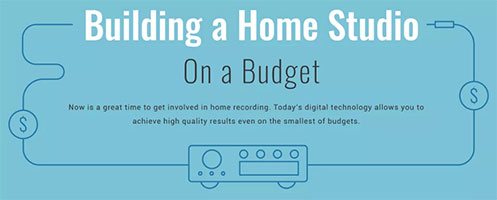How To Build A Home Studio On A Budget

Today we have a guest post from Jonathan Biran of Catz Audio about one of my favorite topics – putting together a home studio without spending a fortune. I have given some advice on that once or twice :-P. See our mini-course “How To Create A Home Recording Studio.”
Jonathan approached me with an infographic on the subject a few days ago and I loved it. He offered to share it (see the bottom of the page), and a post to go with it, here. So here it is. One note before you read on – Jonathan wrote with recording musicians in mind. If you primarily record voice overs (podcasts, video narrations, audio books, or work in the VO industry), certain things may not apply.
Thanks Jonathan!
Jonathan’s Post
The thought of building a recording studio is daunting. Acoustic treatment, boutique audio equipment, microphones, instruments… these tools ARE NOT by any means cheap.
So what is one to do?
Should the aspiring producer drop over a thousand dollars to get started? Is the musician destined to record his or her demos at an expensive studio?
Fortunately, this isn’t the case! The digital age is on our side. Computers can now fit in our pockets, answers to mind-numbing questions can be found in seconds on the internet, and recording studios can be carried in a backpack! It’s never been easier to jump into the realm of recording and audio.
You’ll find many opinions concerning home recording on the interwebs. Some individuals have incredible things to say, while others spread misinformation.
This short post covers the bare necessities of the modern home recording setup. We simply cover what one needs to properly record and mix a demo or full-scale track. Before you read on, remember that the cheapest option is not always the best option; neither is the most expensive option…
The trick is finding a middle ground. For now, let’s be as frugal as possible – covering the best gear for the cheapest price.
What You Need
To properly record, edit, and mix a track, you’ll need to get your hands on an interface, DAW, microphone, monitoring source, some accessories and a decent laptop. This is the bare minimum of what you need.
The interface
Think of an interface as being a translator. Inside of most interfaces is both an analog to digital converter (A/D) and a digital to analog converter (D/A). The A/D converter basically takes the electric signal from a line or mic input, and it converts it to digital bits and samples that a computer can understand. It then reads back those digital samples via the D/A converter so that you can hear the signal from the monitor outputs.
For a starter interface, get something that has at least 2 mic/line inputs, headphone out(s), and monitor outs. Firewire, thunderbolt, or usb 3.0 connectivity should work well.
[Ken here again. One example of what Jonathan means is what I use – a Focusrite Scarlett 2i2.
The DAW (software)
The DAW, or digital audio workstation, works in tandem with your interface. It’s a piece of software that captures what comes into the interface. Think of your DAW as the command center.
A DAW allows you to easily record, edit, mix, and master audio files. The alternative to a DAW is vinyl and tape – these mediums are seldom used nowadays.
[Another note from Ken – My DAW of choice is called Reaper and is amazingly capable with an equally amazing price tag. Check it out here https://reaper.fm. Also, if you are recording primarily voice over stuff, you might not need a “DAW.” You might well be able to do everything you need with a simple audio recording and editing program like Audacity, which is free ;-)]
The Microphone
There are a few categories of microphones. One of the cheaper options is a dynamic microphone (cheap DOES NOT mean “bad” in this case – dynamic mics are fantastic tools).
Shure SM57s are a good pick, as they are durable and great sounding.
[Ken here – though dynamic mics have their place and are great tools, if you want to do intimate vocal recording, you might consider starting off with a large diaphragm condenser mic instead. See my post What Are The Different Types of Microphones? for more on that]
The Monitoring Source
Your monitors are your map and compass. Skimping on monitors isn’t recommended – your monitors will guide you and provide a solid reference.
It’s always recommended to mix on more than one monitor source. Try using both monitors AND headphones/in-ear monitors.
See the infographic for some good choices!
The accessories
Necessary accessories are provided in the infographic. The more accessories you have access to, the more tools you have at your disposal!
The home recording studio should aid you in your production quest. Everyone has a different opinion, so experiment and seek out the tools that fit your style. Find a setup that feels right, and get cracking on your next hit!
[Ken here again – if you are primarily a voice over person (podcasts, narrating videos or actually working in the voice over world), your needs will be different – probably won’t need as much stuff]
The Infographic
Ken here. So what about this infographic we keep talking about? Here is it below:
Please include attribution to catzaudio.com with this graphic.


Hi Ken, Did you ever finish the harmony breakdown for Suite Judy Blue Eyes. I would love it. I am willing to ay to help with your endeavors.
Hi Rick. I did start the project, and I know the harmonies. But I did not finish that. I’ll move it up the priority list. Thanks for the reminder!
Ken